Residence of Trevor Bunning
Kay Place, Nicholls, Canberra, ACT
Roger Jones 1998, 3m., 12 sp. st., mechanical
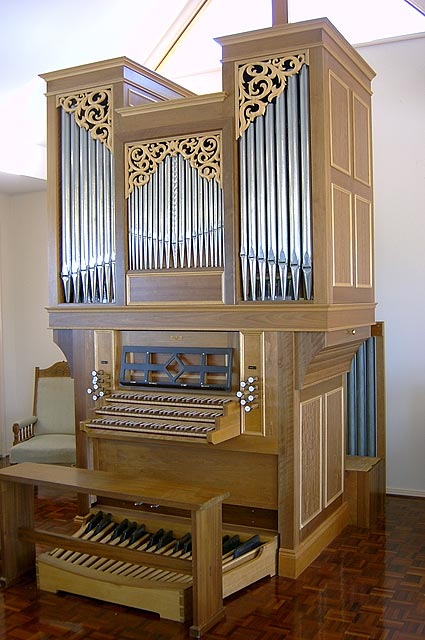
From OHTA News October 1988:
Roger Jones has recently completed at his workshop in Nuriootpa, SA, a three-manual house organ, the result of over two and a half years work.
Roger Jones writes:
All the manual pipework stands on the same level, with a pallet-box at the rear for manual III and one for manual II at the front of the organ, Manual I is a coupler manual, coupling III to II the moment it is played, thus allowing the coupling to be split, so to speak. It would seem that this is a 'first' of this arrangement in modern times in Australia.
The facade pipes are of 55% tin (spotted), and most of the pipework was made in my workshop, as also was the complete coupler assembly and keyboards. Trevor Bunning supplied the pedalboard (which l re-capped) and some very nice rosewood stop knobs. He also provided a complete Viol 8, from TC to the top, from a Nicholson organ (NSW) marked 'Oct/11/00 E.Evans'. He also handed to me a very sad and damaged Oboe 8 TC, presumably from the same Nicholson, as this too was dated 'Oct/24/00' on the TC bell. This pipework may well have been from the Nicholson & Lord organ formerly in St Aidan's Anglican Church, Annandale, NSW, opened in 1901.
I converted this reed to a very successful Cromorne by fitting new cylindrical resonators scaled to a 'sevens' and 'fives' scaling logic. Some may bemoan the fact that I did this, but at least it has had a re-birth, and not just all thrown into the melting pot. It was necessary for me to build a bass octave down to CC.
The eight lowest pipes of the Viol stand at the rear, along with Trevor's Subbass pipes, and speak very promptly, even on two and a half metres of kopex tubing running from the main chest. The pipes from TC to the top are of very low tin content, but responded remarkably to restoration, being almost 100 years old, and it is probably the best sounding stop on the organ. It was necessary to mitre nine of the longest pipes of the tenor octave, so as to fit Trevor's case design. There are 33 speaking principal pipes in the facade. The pipeshades for the casework are to be carved by Trevor Bunning.
In March 2006, Roger Jones replaced the second hand Viol 8' and installed a brand new Salicional 8'. The Salicional has a soft diapason tone and blends better with his baroque sounding chorus. [TB]
The installation at Trevor Bunning's residence was completed on 3-4 October 1998.
| MANUAL I III/II coupler MANUAL II Salicional Rohrgedackt Principal Octave Quartian 19.22 tremulant MANUAL III Gedackt Rohrflöte Nazard Spitzflöte Tierce Cromorne tremulant PEDAL Subbass |
8 8 4 2 II 8 4 2-2/3 2 1-3/5 8 16 |
(replaced Viol 8' March 2006) |
The tremulant can be switched from III down to II via a stop knob
2 hitch pedals (for pedal couplers)
tuning: Kellner proposed Bach temperament
Roger Jones
Chamber organ
Built by 'ACT Pipe Organs' - Roger Jones and Trevor Bunning 2008
3 ranks, mechanical action
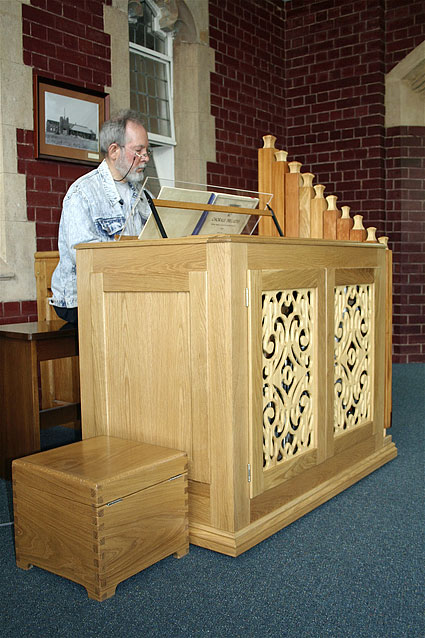
Photo taken at Wesley Forrest at their World Organ Day event
(Oct 19, 2008 - David Short playing). Photo: Trevor Bunning (and one below)
A Mobile Chamber Pipe Organ
During 2006-2008 Trevor Bunning and Roger Jones collaborated under the name 'ACT Pipe Organs' to produce a mobile chamber organ for use at concert and church venues in and around Canberra. Constructed in Trevor's Nicholls workshop, this instrument was designed to accompany soloists, small choirs, instrumentalists and chamber orchestras as well as for use as a continuo instrument.
Set in an American oak case, it is 120 cm long x 80 cm deep x 150cm high and comprises a one manual keyboard and three stops, each stop being a single rank of 58 pipes: Gedackt 8ft, Flute 4ft and Principal 2ft. The reverse coloured keys are made of New Guinea ebony naturals and recycled ivory sharps. The rotating keyboard is held by rear pins, which allow it to move sideways for transposition of one semitone. By transposing the keyboard down a semitone, the organ's pitch becomes compatible with the lower range requirements encountered when playing in an ensemble of period instruments. The organ is tuned to equal temperament but can be re-tuned to mean-tone if required.
The metal pipes are made of a tin-lead alloy known as 'spotted metal' and have been voiced to suit a low wind pressure of 1-3/4 inches. The low mouth cut-ups produce a clear European baroque type sound with a slight 'chiff'.
The fretted pipe screen door panels are of Malaysian Jelutong, a timber widely used in Indonesia for craft work and fine carving. The door pattern is based on intertwined treble and bass clef symbols.
Trevor comes to the profession of organ building from a background as a chartered architect. Over the past thirty years Trevor has developed his organ building skills on a range of projects. Apart from the newly completed chamber organ, he has worked on the restoration and rebuilding of a number of other pipe organs in the ACT.
Sadly, Roger Jones passed away in April 2014. Over a period of several decades he built about ten baroque inspired mechanical action pipe organs at his manufactory in South Australia, and was also well known for his skilful restoration of the very oldest surviving organs built in Australia by the remarkable early German settlers Johann Kruger and Daniel Lemke.
| Manual Gedackt Flute Principal |
8 4 2 |
Compass 58 notes
Keyboard transposable by 1 semitone for accompanying early music
Mechanical action, Electric blower (Laukhuff)
Casework: American White Oak, Carved screens: Jelutong
Twin wheel castors for mobility
Available for hire and to be stored in various locations.
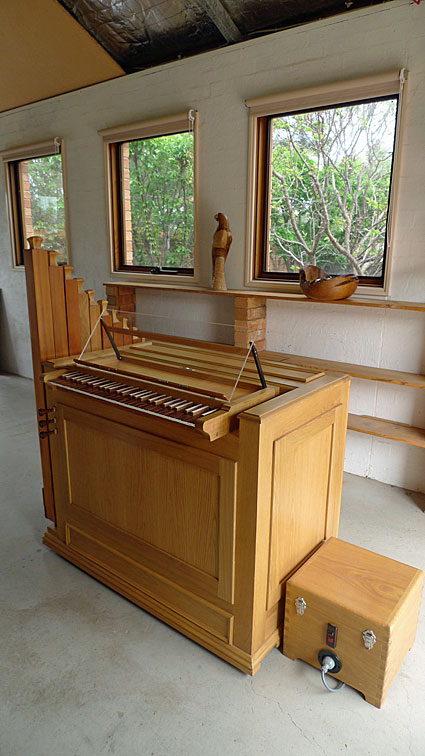
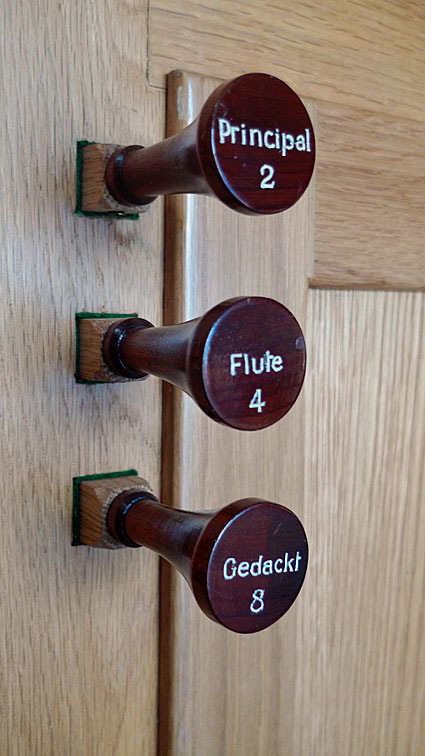
Two photos above: Trevor Bunning (January 2020)
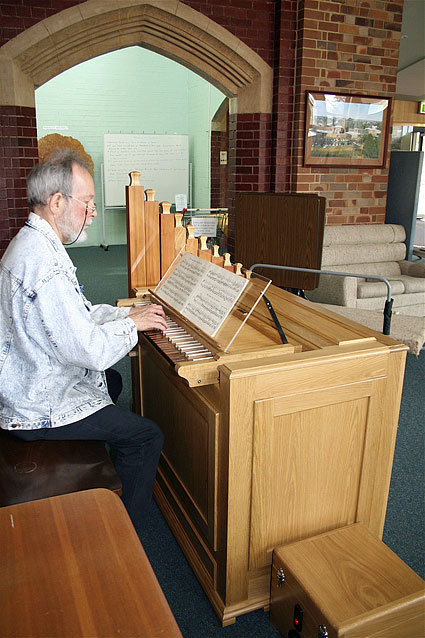
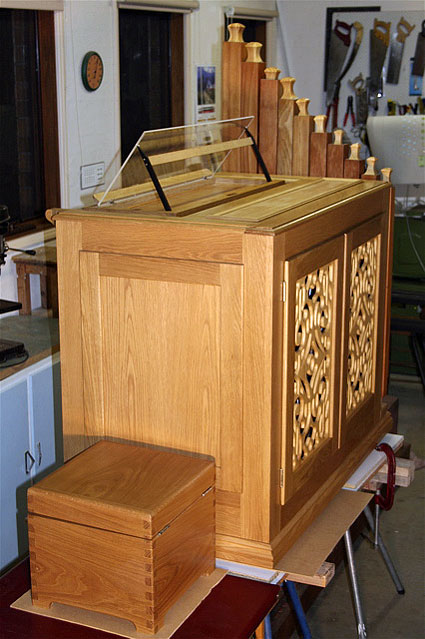

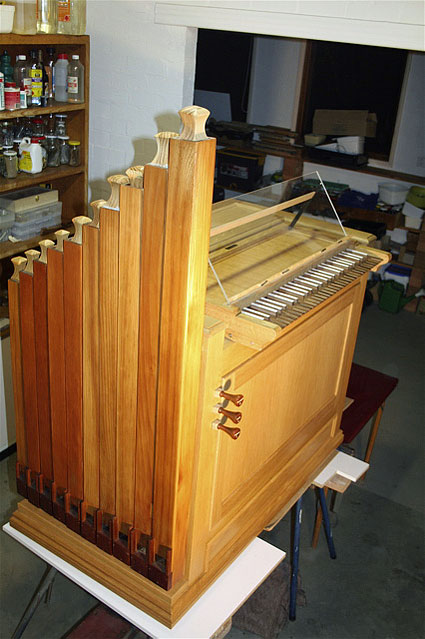
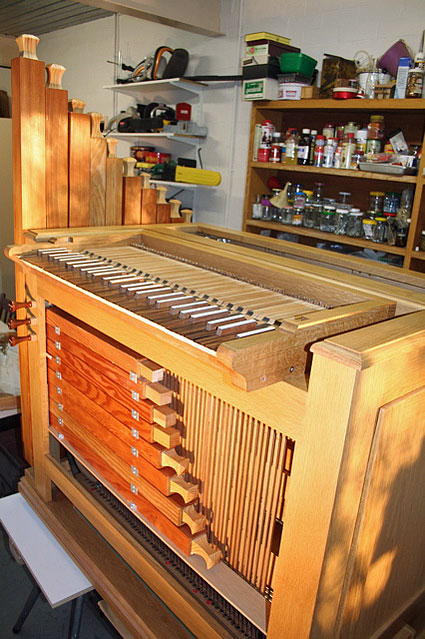
Photos: Trevor Bunning (Sept 2008)